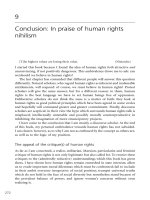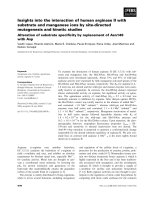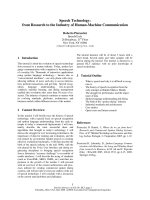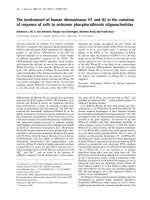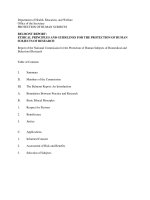The modes of human rights literature
Bạn đang xem bản rút gọn của tài liệu. Xem và tải ngay bản đầy đủ của tài liệu tại đây (1.3 MB, 144 trang )
THE MODES OF
HUMAN RIGHTS
LITERATURE
Towards a Culture without
Borders
Michael Galchinsky
The Modes of Human Rights Literature
Michael Galchinsky
The Modes of Human
Rights Literature
Towards a Culture without Borders
Michael Galchinsky
Georgia State University
Atlanta, Georgia, USA
ISBN 978-3-319-31850-9
ISBN 978-3-319-31851-6
DOI 10.1007/978-3-319-31851-6
(eBook)
Library of Congress Control Number: 2016943524
© The Editor(s) (if applicable) and The Author(s) 2016
This work is subject to copyright. All rights are solely and exclusively licensed by the
Publisher, whether the whole or part of the material is concerned, specifically the rights of
translation, reprinting, reuse of illustrations, recitation, broadcasting, reproduction on
microfilms or in any other physical way, and transmission or information storage and retrieval,
electronic adaptation, computer software, or by similar or dissimilar methodology now
known or hereafter developed.
The use of general descriptive names, registered names, trademarks, service marks, etc. in this
publication does not imply, even in the absence of a specific statement, that such names are
exempt from the relevant protective laws and regulations and therefore free for general use.
The publisher, the authors and the editors are safe to assume that the advice and information
in this book are believed to be true and accurate at the date of publication. Neither the
publisher nor the authors or the editors give a warranty, express or implied, with respect to
the material contained herein or for any errors or omissions that may have been made.
Cover illustration: © Melisa Hasan
Printed on acid-free paper
This Palgrave Macmillan imprint is published by Springer Nature
The registered company is Springer International Publishing AG Switzerland
For Gideon and Rafi
PREFACE
In September 2004, I traveled to Russia with a delegation of academics
to build connections with the emerging Jewish studies departments there,
and also to interview human rights activists. We could get a pretty clear
sense of the state of human rights at the time just by looking at the public monuments. As a marker of one Russian impulse, Tsereteli’s massive
and hideous new monument of Peter the Great, sitting in the middle of
the Moscow River, seemed like a portent of Putin’s imperial ambitions.
But the imperial impulse was countered by what we found in a sculpture
park outside the Tretyakov Gallery in central Moscow. This was where,
after 1989, city officials brought the marble and bronze Lenins and Stalins
and Dzerzhinskys, which had stood in front of government buildings and
bestrewn public squares, but which now no longer had a state purpose. At
first, the officials brought the sculptures to the park and left them as they
were, leaning on their sides. The area came to be called (colloquially, not
officially) the Park of Fallen Idols.
Eventually the collection contained over 700 Soviet-era monuments.
In the heady days of the new Russia, the City of Moscow commissioned
artist Evgeny Chubarov to surround some of the examples of triumphant
socialist realism with more contemporary sculptures. When we entered
the park we came upon Stalin, twenty feet high, striding purposefully into
history. Chubarov had surrounded the dictator with sculptures of his victims, including a massive cement cage with iron bars, filled with over 300
individualized ceramic heads. In this way the Park of Fallen Idols offered
a layered reading of Russian history.
vii
viii
PREFACE
Not many states preserve the monuments of their discredited pasts.
Writing a decade after the Soviet tanks crushed the Prague Spring, in The
Book of Laughter and Forgetting, Milan Kundera described the more typical fate of monuments: “Wandering the streets that do not know their
names are the ghosts of monuments torn down. Torn down by the Czech
Reformation, torn down by the Austrian Counter-Reformation, torn
down by the Czechoslovak Republic, torn down by the Communists;
even the statues of Stalin have been torn down” (Kundera, Laughter and
Forgetting 1994, 217). It is just because successive governments undertake strenuous programs of public forgetting that citizens in every country
should demand their own parks of fallen idols. Every government should
be required to maintain its own standing rebuke. Its citizens should have
access to symbols that assert, “However things are today, they were otherwise yesterday, and might be otherwise tomorrow.”
Human rights symbols, like the fallen idols, arouse strong public feelings, which do not always find a channel in the official exchanges of actors
in the international human rights system. The various monitoring bodies
at the United Nations (UN) tend to marginalize affect, in an effort to
make human rights justiciable. Non-governmental organization (NGO)
reports also relegate the strong emotions of victims of rights violations
to sidebars, focusing their attention on testimony that has evidentiary
value. In the academic realm, too, there has been too little discussion of
the emotional aspects of human rights discourse. This is in part because
the study of human rights has usually been undertaken by legal scholars
and political scientists, whose interests lie elsewhere. Trauma studies have
explored the consequences of human rights abuse for individual victims’
psyches, but how societies, collectively, deal with their traumas is a question only beginning to be investigated in the scholarly literature on transitional justice. There is still much work to be done.
Compared to human rights law, human rights culture is generally not as
concerned about the juncture between facts and norms (Habermas 1998) as
it is about the juncture between feelings and forms. It is less about establishing
an agreed code, and more about sharing individual experiences. Emotionally
resonant human rights art typically doesn’t change laws or regimes; rather, it
seeks to change the prevailing ethos, by depicting what human rights mean
for the individuals who are deprived of them, who witness the abuse, who
perpetrate it, who mourn the victims, who intervene, who provide aid, or
who transmit the stories. By relating such experiences, human rights culture
tries to shape a durable recollection for the wounded community.
PREFACE
ix
In the past decade, there has been a surge in the number of humanities
scholars studying human rights literature and art. Cultural sociologists have
begun to look at the symbolic, meaning-making processes associated with
human rights practices (e.g., Alexander 2007). Communications theorists
have considered the effect on viewers of the framing of human rights issues
in the media (e.g., Borer 2012). This book contributes to the humanistic
study of human rights by offering an account of two of the major modes of
human rights literature—lament, the literature of mourning, and laughter,
the literature of resilience. These literary modes exemplify art that reflects,
and reflects on, a developing culture of universal civility.
Thanks to everyone at the Yale Center for Cultural Sociology, who
helped me develop my ideas on global civil culture by inviting me to present a workshop in 2008. The Center’s journal and conferences have been a
source of continuing inspiration and learning for me. Thanks to Tristan Borer
for encouraging me to develop my ideas and including an early version of
Chap. 1 in her collection as “Framing a Rights Ethos: Artistic Media and the
Dream of a Culture without Borders,” in Borer, ed., Media, Mobilization,
and Human Rights: Mediating Suffering (New York: Zed, 2012), 67–95.
Thanks, too, to the editors of Human Rights Review, for publishing an early
version of Chap. 2—originally as “Lament as Transitional Justice,” Human
Rights Review 15.3 (2014): 259–281—and permitting me to revise and
reprint it here. Colleagues at meetings of the Modern Language Association,
the American Comparative Literature Association, and the International
Studies Association have offered wonderful support and advice—in particular
Alexandra Schultheis Moore, Elizabeth Swanson Goldberg, Greg Mullins,
and Zoe Norridge. I am also grateful to the colleagues in my international law
track, whose work has often overlapped in interesting and unforeseeable ways
with my culture track: Kurt Mills, Melissa Labonte, and David Jason Karp.
I am grateful to Georgia State University for the Provost’s Faculty
Fellowship and professional leave that enabled me to complete this work.
Many of my colleagues have offered their good counsel and encouragement on various aspects of the project, especially Randy Malamud,
LeeAnne Richardson, Sarah Higinbotham, and my fellow affiliates of
GSU’s Center for Human Rights and Democracy. My editor at Palgrave,
Brigitte Shull, and the anonymous reviewers offered useful counsel.
My boys, Gideon and Rafael, are dedicated to soccer and to tikkun
olam (the Jewish concept of repair of the world). They’re wise enough
to know they don’t have to choose. As Emma Goldman once put it, “If I
can’t dance, it’s not my revolution.”
ACKNOWLEDGEMENTS
Parts of Chap. 1 are reprinted and/or revised, with kind permission from
Zed Books, from Michael Galchinsky, “Framing a Rights Ethos: Artistic
Media and the Dream of a Culture without Borders,” in Tristan Borer,
ed., Mediating Atrocity: Media, Mobilization, and Human Rights (New
York: Zed Books, 2012), 67–95.
Parts of Chap. 2 are reprinted and/or revised, with kind permission
from Springer Science+Business Media: Human Rights Review, “Lament
as Transitional Justice,” 15 (2014), 259–281, Michael Galchinsky.
xi
CONTENTS
1 The Dream of a Culture Without Borders
1
2
Lament as Transitional Justice
27
3
Laughter and the Subjected Subject
53
4 Towards a Global Civil Culture
83
Works Cited
113
Index
125
xiii
CHAPTER 1
The Dream of a Culture Without Borders
Abstract Chapter 1, “The Dream of a Culture without Borders” argues
that the role of human rights literature is to reflect the desire for university civility to a global citizenry. Writers begin to develop a culture without borders through their use of four literary modes: protest, testimony,
lament, and laughter. These modes are formal means of articulating the
sociopolitical emotions triggered wherever human rights crises occur. The
book focuses on two of the modes: lament, the literature of mourning;
and laughter, the literature of resilience. Adopting an approach known as
affective formalism, the chapter surveys key methodological, institutional,
theoretical, and operational challenges for this approach.
Keywords Human rights • Literary modes • Affect • Formalism
• Cosmopolitanism • Civil society
Human rights culture has many tasks to perform. In literature, film, and
the visual and performing arts, works of human rights culture seek to
reflect and reflect on our fundamental dignity, equality, and freedom.
Human rights culture draws on the theory of natural rights first declared
during the American and French revolutions, and later institutionalized
in the Universal Declaration of Human Rights (UDHR) and the complex
array of treaties, monitoring bodies, and courts that followed. At the same
time, human rights artists draw on the universalistic strains within their
own particular religious, cultural, and ethnic traditions.
© The Author(s) 2016
M. Galchinsky, The Modes of Human Rights Literature,
DOI 10.1007/978-3-319-31851-6_1
1
2
M. GALCHINSKY
Human rights culture shares civic and ethical functions with human rights
law, but while the orientation of the law is vertical, reaching down from
government bodies to individuals, the orientation of rights culture tends to
be horizontal, with the artist appealing as a human being directly to his or
her fellows. In this way, works of human rights culture participate in the
public sphere, in Habermas’s sense (Habermas Public Sphere 1991; Slaughter
2007). Along with the work of non-governmental organizations (NGOs),
news media, and social media, culture helps construct the civil society in
which human rights can be meaningful. The human rights artist assumes
that neither the United Nations (UN) nor a national government can simply
compel people to respect each other’s rights: people have to want to. The
artist seeks to produce and reflect that desire to a national or global citizenry,
striving to ground the formal rights system in an informal rights ethos.
Only rarely does a work of human rights culture produce a direct outcome—the change in a policy or law, the release of a prisoner, or the
overthrow of a regime. Its work is generally more subtle, indirect, and
long-term: it helps to produce what cultural sociologists call a “structure
of feeling,” a socially constructed and sanctioned sympathy with others
across identity differences (see, e.g., Williams 1997; Alexander 2007). In
other words, human rights art seeks to cultivate rights-oriented “habits
of the heart” before abuses start, so that when they do, a rights discourse
will already be in place to stand against the discourse of the violators
(Durkheim 1972, 1992, 1995; Hunt 2007; Mill 1989; Sontag 2003;
Tocqueville 1969).
In Inventing Human Rights, historian Lynn Hunt provides a demonstration of how literature produced a rights-oriented structure of feeling
in the rights revolution in eighteenth-century France. Novels like Samuel
Richardson’s Pamela modeled empathy across social lines. As Hunt
(2007) tells us:
In the eighteenth century, readers of novels learned to extend their purview
of empathy … across traditional social boundaries …. As a consequence,
they came to see others—people they did not know personally—as like
them, as having the same kinds of inner emotions. Without this learning
process, “equality” could have no deep meaning, and in particular no political consequence. (40)
By promoting identification with the interior lives of people who had
been considered unequal, novels prepared “the seedbed” of the French
THE DREAM OF A CULTURE WITHOUT BORDERS
3
Revolution’s declaration of human rights (Hunt 2007, 58). Critics have
made similar arguments about the role of fiction in helping build support
for the American civil rights movement, among other cases.
Human rights culture performs its many tasks by addressing multiple
audiences. Most rights works are directed to their national audiences and
speak to national crises in a global dialect. A small proportion of these—in
addition to addressing their national audience—also reach out to a global
public. At the national level, we can split the audience into three parts: the
abused, the witnesses and allies, and the perpetrators. The artist’s fellow
sufferers look to the work for voice, protest, satire, and commiseration.
The witnesses and allies look to it for information, history, inspiration,
and a focal point for grief. To the perpetrators, the work is directed as testimony and protest. Addressing all three audiences simultaneously can be
a difficult task, so artists sometimes limit the work’s distribution to one of
the audiences: for example, protest songs and poems passed hand to hand
among dissidents or distributed via selective Listservs create solidarity and
build resistance.
Those works of human rights culture that reach for the global public aim to inspire international outrage and intervention. Here special
difficulties arise because, for reasons to be explored in this chapter, it’s
not clear that a global public exists. But the fantasy of a global audience
provides many artists—under conditions of censorship and threat of
punishment at home—a lifeline beyond the national frame. We could
say that the dream of broadcasting rights works to the world is the
dream of a “culture without borders”—a yearning to tap into a universal structure of feeling.
1
PURPOSES
Human rights culture raises many questions: beyond the general aim
of establishing an ethos among their multiple audiences, to what more
specific purposes do human rights artists set themselves? What aesthetic
modes—or formal approaches—have they adopted to fulfill their purposes? And what problems have they, their distributors, critics, and audiences faced in creating a human rights culture?
Apart from the general task of engendering sympathy beyond identity, human rights artists set themselves a variety of more specific tasks.
They seek to clarify or dispute historical narratives, protest current practices, foment resistance, promote reconciliation, express solidarity, inspire
4
M. GALCHINSKY
others, and mourn. With so many purposes, it’s no wonder that works
in this field are so difficult to analyze as a class. To begin to make some
analytical headway, cultural critics have recognized the need to adjust their
habits of reception.
The readjustment has, in the past several years, been increasingly led by
the new field of human rights literary criticism. Human rights literature
has had its own special-topic section in PMLA, the journal of the Modern
Language Association of America. Important sole-authored works of
criticism like Joseph Slaughter’s Human Rights Inc. (2007) emerged.
Slaughter and Sophia McClennen (2007) edited a special-topic issue of
Comparative Literature Studies, and Routledge published a volume of
articles edited by Elizabeth Swanson Goldberg and Alexandra Schultheis,
Theoretical Perspectives on Human Rights and Literature (2012), as well
as a volume on teaching human rights literature in the Modern Language
Association (MLA) series on pedagogical approaches. Monographs by
Swanson Goldberg, James Dawes, Kay Schaffer and Sidonie Smith, Zoe
Norridge, and others (see bibliography)—many of whom have attended
the annual seminar at the American Comparative Literature Association
for over a decade—have built up the field.
Slaughter’s book offers an ambitious argument about the parallelism
between legal discourse on human rights and the narrative form of the
coming-of-age novel: both value the individual’s development, socialization, and incorporation into the larger community. Both take for granted
a plot trajectory of progress—or document the obstructions to such
progress—a plot that finds its source in Enlightenment thinking about
the modern subject and has increasingly found a foothold in postcolonial
thinking as well. The coming-of-age novel, Slaughter says, is the “novelistic wing of human rights” (25); indeed, for him it is the exemplary type
of such literature.
Slaughter suggests that “other cultural forms … may make imaginable alternative visions of human rights” (Slaughter 2007, 4), mentioning other novel subgenres such as the picaresque, romance, epistolary,
and sentimental. Much of the critical discussion has followed Slaughter by
focusing on narrative forms, and indeed I will add to this critical dialogue
in my discussion of novels that contribute to the literature of resilience.
However, taking up Slaughter’s invitation to expand the range of genres,
I will demonstrate that a range of non-narrative forms, including poems,
plays, sermons, and pamphlets, have made significant contributions to
human rights literature, especially to the literature of mourning.
THE DREAM OF A CULTURE WITHOUT BORDERS
5
In expanding the discussion beyond narrative, the temptation is to
proceed with an expanded socio-historical investigation of genres. But
while that kind of study is necessary, this study undertakes a different kind
of analysis—not of genre, but of mode. Genres are historically evolving
forms of writing, their features contingent on the time and place in which
they are put to use. By contrast, modes are major forms of writing that
persist in many times and places. A genre contains a spectrum of possibilities activated contingently in relation to a specific historical context. As
Franco Moretti has shown, genres have a life cycle: they are born, mature,
evolve, die off, and may be born again, perhaps amalgamated with features from another genre (Moretti 2007). By contrast, a mode remains
the same no matter where or when it is produced. Modes are transspatial and transhistorical, because they are logically derived rather than historically conceived. Aristotle famously identified three major modes: lyric
(a single voice), drama (multiple voices), and narrative (multiple voices
organized by an overarching teller). Later critics and historians, such as
Northrop Frye and Hayden White (Frye 2007; White 1975), have elaborated the modal concept. The idea of modes seems suited to human rights,
which scholars characterize as similarly rationally derived, transspatial, and
transhistorical.
In the last thirty years the movement in the arts and criticism has been
toward multiculturalism—the exploration and celebration of cultural
diversity and difference. There have been, of course, good reasons for this
approach. Yet a human rights art asks audiences to follow the pendulum
as it swings in the other direction. It asks audiences to balance multiculturalism with a kind of humanism—and this time not an exclusively
Western-oriented humanism. While recognizing the uniqueness of a given
community’s experience (as per the multicultural model), it asks audiences
to recognize those aspects of the experience that can be communicated
across social divides. It challenges critics to adopt concepts that are independent of local or national context, of historical period or artistic genre.
It asks them to imagine an aesthetic that transcends nationality, race, and
ethnicity; gender and sexuality; religion and class.
This book aims to offer a constructive response to these challenges. I
propose a model of literary forms and affects that emerge frequently—and
transnationally—in writers’ responses to human rights crises. Thus the
book is intrinsically comparative. I also argue that human rights culture
is a subset of a larger phenomenon, which I term global civil culture and
describe at length in Chap. 4. This book does not set out to complete
6
M. GALCHINSKY
the work it undertakes, but I hope the model it proposes may be of use
to other critics as we continue to develop what Swanson Goldberg and
Schultheis Moore have termed the “interdiscipline” of human rights cultural criticism (Swanson Goldberg and Schultheis Moore 2012).
2
MODES
Is there a tradition of human rights literature, and if so, what does such a
tradition look like? I argue that critical analysis can identify a human rights
literary tradition, but it is not necessarily a self-conscious tradition, from
the writers’ standpoint. Writers included in this study may or may not have
intended to contribute to a tradition of human rights literature, and they
may or may not have been aware of other writers in the tradition. Samuel
Moyn makes a cogent argument in The Last Utopia that the human rights
movement—whether in its minimalist or maximalist forms—was not and
will not be the only rhetorical game in town (Moyn 2010). The writers
discussed here might, for example, think of themselves as rebels, as feminists, as postcolonial writers, or as child soldiers, but not as human rights
writers. Nonetheless, I consider their work as part of a tradition of human
rights literature. I use the term “tradition” to refer to a critical ascription of similarities among works produced under analogous experiences of
human rights restrictions and violations, loss, and post-crisis rebuilding.
Here, identifying a tradition of human rights literature is a retrospective,
critical practice.
To be sure, there are cases in which writers are aware of others working
in the same genre, style, or mode, and are writing self-consciously to, for,
against, or about each other. Moreover, many of the writers in this book
have the intention of seeking an audience outside their national frame who
can hear their cry and be outraged and intervene. While neither denying
nor minimizing the significance of such intentions, I identify a human
rights literary tradition primarily on formal grounds—by pointing to a set
of common literary practices, or modes, which such literature explores.
These formal elements are, in my view, what make the literary aspects of
human rights literature recognizable as such.
This type of literature gives voice to certain core sociopolitical emotions triggered by human rights situations. A non-exhaustive list of these
includes a communal sense of fear, outrage, and desire for solidarity
(protest); the urge to witness, remember, and narrate (testimony); the need
to satirize, express the absurdity of life under violation, and find relief
THE DREAM OF A CULTURE WITHOUT BORDERS
7
(laughter); and the yearnings for mourning, renewal, and reconciliation
(lament). I hypothesize that writers have associated such emotions with
particular types of symbolic structures and forms, and I seek to test whether
such structures and forms are, in fact, unbound by territory or chronology, finding expression wherever rights violations occur. Although each
human rights crisis is exceptional, I claim that the literary texts produced
in response to them exhibit certain resemblances—in the types of human
subjects they depict, in the modes of literary expression they embrace, and
in the affects to which they give voice. That is, a modal criticism looks for
large-scale formal patterns that cross temporal-spatial boundaries. This is
similar to what Franco Moretti refers to as “distant reading” (as opposed
to close reading), a meta- or macro-level kind of analysis which he claims
is “a specific form of knowledge: fewer elements, hence a sharper sense
of their overall interconnections. Shapes, relations, structures. Forms.
Models” (Moretti, 1).
Distant readings for large-scale formal patterns do not depend on an
intentionalist argument. Antjie Krog, the South African journalist and
poet, may or may not have been aware of the writings of Primo Levi, the
Italian Jewish Holocaust writer, when she wrote Country of My Skull—but
the exigencies of the human rights situations she and he are addressing,
the sociopolitical emotions triggered by those exigencies, and the shaping
pressure those exigencies and emotions exert on literary technique, led
Krog and Levi (despite their different national situations) to adopt certain
formal practices, common to laments. Whether the writers intended to
contribute to that mode is, from the formal perspective, useful but not
requisite information.
To maintain that human rights literature is a formally coherent tradition of modes is not to deny the importance of historical context in a full
appreciation of a given work. Like all works of literature, human rights
works cannot be fully understood without a knowledge of the generic,
social, biographical, political, discursive, and institutional forces that conditioned and shaped them. Indeed, much of the excellent human rights
literary criticism over the last decade has taken some kind of generichistoricist approach.
To give one example, Kay Schaffer and Sidonie Smith, in Human
Rights and Narrated Lives: The Ethics of Recognition (Schaffer and Smith
2004) give a historicist account of first person human rights narratives,
arguing that such narratives emerge in some cases but not others due
to particular sociopolitical conditions. Certain “representational frames”
8
M. GALCHINSKY
(134) make human rights narratives possible, while other frames exclude
rights narratives. Schaffer’s and Smith’s account lets us see that narratives
by women who served as sexual slaves in the Japanese military’s system of
“comfort stations” during World War II did not emerge for 50 years after
World War II: such women were written off as war prostitutes rather than
as victims of sexual violence. But then, starting in the late 1980s and into
the 90s, narratives by and about comfort women that framed their stories
within the language of human rights abuse began to emerge. Schaffer’s
and Smith’s account of the changing conditions that make new frames
available helps us to gain an appreciation of the social forces affecting
particular storytellers. It also enables an analysis of the various reception
histories of human rights narratives as they circulate globally, “beyond the
local sites of telling” (146)—whether in other national markets, in UN
forums, in NGO reports, or among members of their group’s diaspora.
The historicist approach reminds us that every human rights crisis
is unique for those who suffered under it, and the rhetoric, discourses,
and tropes adopted by victims and perpetrators vary from place to place.
When Hitler referred in Mein Kampf to Jews as “parasites,” he did not
invoke precisely the same kind of hate speech as that of the Radio Rwanda
announcer who called Tutsis “cockroaches.” I am conscious of wanting
to guard against homogenizing differences into another form of Westerncentrism, where the “universal” is just the West in disguise (GutiérrezMouat 2013). This book recognizes important differences among human
rights literary works: genres, for example, develop locally and contingently.
Laughter seems to be (generally speaking) a mode to which male writers
have been drawn, whereas (generally speaking) lament has been identified
with the “feminine” and often practiced by women, for reasons examined
below. Certain types of laughter emerge more frequently in literatures of
the Soviet and post-Soviet states, while others seem to bubble up in literatures written in response to Latin American dictatorships.
Yet the uniqueness of the Tutsis’ and Jews’ experiences in the above
example does not obscure the analogies between the rhetoric used to delegitimize them: both “parasites” and “cockroaches” were dehumanizing
metaphors aimed at placing the target communities beyond the circle of
national belonging, rights, and care. In a similar way, this book strives to
locate the shared, human dimensions of human rights literature. The focus
is on the aspects of the literature that seem most widespread, even while
other aspects of the same literary expressions remain local, particular, and
distinct. If the desire to see human rights respected ever can be global,
THE DREAM OF A CULTURE WITHOUT BORDERS
9
I suggest, that desire will depend on the formation and maintenance of
some kind of common structure of feeling, and some common symbolic
forms of expression. The common structure of feeling I have in mind
might be termed universal civility. The symbolic forms that carry this
feeling I identify as the modes of protest, testimony, lament, and laughter.
I observe throughout the book that the affects intrinsic to a given mode
can be expressed in works diverse in terms of their geographic origin;
language(s); ethnic, religious, and national settings; gender and sexuality
of the author; and chronological period. Modes cross such boundaries
more readily than genres, because they are the more capacious forms, the
macro-forms. As Northrop Frye, the most prominent modern champion
of modal analysis, asserted, a mode is “contemporary with its own time
and contemporary with ours” (Frye 1957, 51)—as well as with the time of
the other writers in the same mode, whenever they wrote. In a similar way,
my claim is that literary reactions to human rights situations share certain
stable structures no matter where or when they were produced, and they
share a common cast of characters—such as the victim, the violator, the
witness, and the judge. In these respects, the modes of human rights literature are non-contingent and widespread.
Both Frye and the modal historiographer, Hayden White, agree that
there are five fundamental modes of prose narrative, but while they agree
on two of them—romance and irony—they name the other three modes
differently. Frye names the remaining modes myth, the high mimetic, and
the low mimetic. White prefers tragedy, comedy, and epic (or chronicle).
In my treatment of the modes, I use both of the agreed modes: romance
and irony. I identify protest as a form of romance (the romance of the
higher ideal), and argue that human rights laughter dwells in the ironic
mode. The mode I call testimony is closest to White’s fifth mode, the
epic or chronicle. Lament combines aspects of White’s tragic and comic
modes, specifically, tragedy’s sense of a world unmade with comedy’s
desire for renewal and reconciliation.
Each text analyzed under a given mode has been chosen because it
exemplifies certain elements of that mode. Thus, for example, each novel
discussed in Chap. 3 on laughter reveals a different aspect of human rights
laughter: laughter from below, laughter from above, pathetic laughter,
paranoid laughter, and so on. In Chap. 2 on lament, each text displays
one or more of the elements of lament, such as the figure of the weeping
mother or the speaking ghost, or the tropes of parataxis or synecdoche.
This inclusionary principle—inclusion by formal element—attempts to
10
M. GALCHINSKY
illuminate the internal coherence, complexity, logic, and beauty of each
mode, as it seeks to give voice to a range of affects. Texts categorized by
human rights modes have the virtue of being thematically, emotionally,
and formally connected. I try to test whether comparative readings among
texts in the same mode bring to light larger, transnational patterns.
Following the method adopted by Frye and White, I begin by offering a descriptive catalog of each mode in turn. At this point, I describe
them, heuristically, as distinct ideal types, but as we will see throughout
the book, the modes are not as separate and distinct as they appear in the
catalog.
Protest
From revolutionary political pamphlets to slave narratives to prison memoirs to blogs, polemics have participated in horizontal protests among
citizens. (For examples of the literature of protest, see the bibliography.)
Protest encourages the public to shame abusive governments and appeals
to what Emile Durkheim called “collective ideals” (Durkheim 1972, 425)
and what the Preamble of the UDHR calls “the conscience of mankind”
(Universal Declaration). It represents the romance of an ideal—the “last
utopia” of human rights, in Samuel Moyn’s terms (Moyn 2010). It wears
its cause on its sleeve, reading as a manifesto or prophetic indictment.
Works like Richard Attenborough’s film Cry Freedom (1987), which dramatizes the South African government’s killing of Steven Biko, a leader
in the anti-apartheid movement, represent collective indignity through
the eyes of one. Alexander Solzhenitsyn’s brief and moving novel, A Day
in the Life of Ivan Denisovich (2000), tells the story of the Siberian gulag
through a single prisoner’s experience. The narrator’s freedom to travel
inside the protagonist’s head shows us the world of violations through
the experience of the one who suffers them. Narrative interiority—the
view from the inside—evokes the reader’s sympathetic identification in a
way that no exterior reportage can do. Simply by allowing readers in and
permitting them to see that a character in an oppressive regime can still
think for himself, a protest novel effectively represents a zone of freedom
that eludes a regime’s best efforts at social control.
Because its purpose is to provoke public outrage, protest is drawn to
represent the most extreme forms of suffering—mass graves, summary
executions, starvation, medical experiments, and so on. This tendency
to gravitate toward extreme violence can prevent it from depicting more
THE DREAM OF A CULTURE WITHOUT BORDERS
11
ordinary, banal forms of evil, like the bureaucratic terror found in less
direct, more ironic works such as Kafka’s The Trial or Orwell’s 1984.
One of protest’s most pervasive fictional genres is the Bildungsroman,
the novel of development. Joseph Slaughter has shown that this form is
congruent with the UDHR’s assertion that everyone has the right to “the
full development of the human personality” (see UDHR Art. 22, 26(2),
29). Bildungsromane from the nineteenth century, but especially those
written after the UDHR was proclaimed, perfectly capture the changing
emphasis in international law from an arena restricted to relations between
states to an arena in which the individual human person is a subject of
increasing concern. By immersing readers in the protagonist’s struggles,
such novels represent protests against the efforts of violator states to
restrict human potential.
Ironically, however, in making the protagonist undergo abuses typical
of the crisis, protest runs the risk of abstracting the individual into a type—
the type of the human being in extremis, the one who represents many,
the survivor who silences his own voice in order to give voice to the dead.
In the process of abstraction the unique personhood that human rights are
meant to protect may sometimes be lost. Protest’s romance may produce
unintended ethical and aesthetic consequences.
Testimony
Like protest literature, the literature of testimony focuses a reader’s attention on a single case rather than on general reportage. In this way it appeals
to the reader’s narrative greed. Even if, as in The Diary of Anne Frank
(Frank 2002), we already know the ending in advance, the individualized
focus enables the reader to feel what she already knows. In Hotel Rwanda
(George 2004), as we follow the plight of Paul Rusesabagina, we witness
the genocide next to him: we are there on the ground, sharing what he
knows and what he doesn’t.
While protest calls for present action against continuing injustices, testimony seeks to establish what happened in the past for future generations.
It is a form of chronicle. Because its central theme is bearing witness,
testimony often takes the form of memoir, oral history, or fictionalized
versions of these. (For examples, see the bibliography.) Poets have also
witnessed to the brutality they suffered. Anyone who has watched or read
the fascinating proceedings of the South African Truth and Reconciliation
Commission will recognize that testimony raises the question of how we
